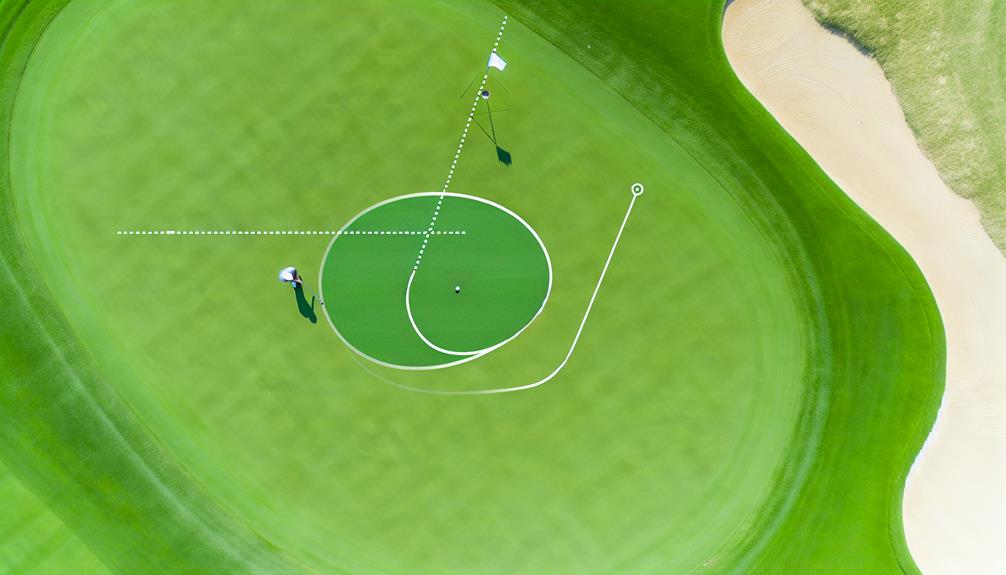Just like a painter uses his brush to create detailed art, you use your putter to command the golf ball's journey to the hole on the green. Mastering distance control in golf putting is a fine art that requires not only skill but also an intimate understanding of the game's nuances.
This guide will help you hone your touch on the green, finding the perfect rhythm between your stroke and the ball's roll. However, a word of caution: this is not an overnight process. There's a bit more to it than you might initially think.
Understanding Distance Control Basics
Before you can master the art of golf putting, it's crucial to understand the basics of distance control. Distance control isn't just about how far the golf ball travels, but how accurately you can gauge that distance. It's a skill that combines your grip strength and visual perception.
First, let's talk about grip strength. You've got to hold the club confidently, but not too tightly. A firm grip allows you to control the putter's swing and direction better. However, be careful not to strangle the club. Too much grip strength can lead to reduced wrist flexibility, affecting the accuracy of your putts.
Now, onto visual perception. It's all about your ability to analyze the green terrain and estimate the distance to the hole. You have to consider the slope, the grass type, even the day's weather. A good golfer can visualize the ball's path and adjust their stroke accordingly.
Importance of Stroke Length
Understanding the importance of stroke length in golf putting is essential, as it significantly impacts your distance control and overall game performance. You see, stroke length isn't just about how far you pull back and push through the ball. It's also about consistent stroke mechanics and club selection.
Let's talk about stroke mechanics. Your stroke length directly affects the speed and angle of the ball. You've got to establish a consistent length that lets you control the ball's speed. Too long, and you'll likely overshoot. Too short, you'll undershoot. It's about finding the right balance.
Now, club selection plays a role too. Different clubs have different lengths. So, you'll need to adjust your stroke length based on the club you're using. It's not a one-size-fits-all strategy. For instance, a shorter club requires a smaller stroke length.
Proper Posture and Alignment Tips
In the realm of golf, maintaining proper posture and alignment can significantly enhance your putting distance control. Let's dive into some key tips to help you develop these crucial skills.
Begin by establishing a good stance. Stand with your feet shoulder-width apart, and slightly bend your knees. This position provides stability and balance.
Next, focus on your grip techniques. Hold the club lightly, not tightly. Your hands should form a ‘V' shape, with your thumbs pointing towards your body. Keep your grip consistent to ensure accurate, controlled shots.
Now, let's talk about alignment. Your feet, hips, and shoulders should be parallel to the target line. This aids in directing the ball towards your desired location. To check your alignment, position your club on the ground, pointing towards the target. Stand parallel to the club, and you're good to go.
Eye coordination plays a vital role too. Your eyes should be over the ball, enabling you to see the line of the putt clearly. This helps in gauging the distance and direction of the putt.
Implementing Effective Practice Drills
Having mastered the fundamentals of posture and alignment, let's now shift our focus to implementing effective practice drills that will further enhance your putting distance control. It's essential to understand that practice makes perfect, but it's even more vital to practice smartly and efficiently.
Drill variations are your best friend. Don't stick to a single drill routine; diversify your practice regimen. Try drills that focus on different distances and angles. For instance, set up a series of balls at varying lengths from the hole and aim to get each one in consecutively. This will challenge your control and adaptability at different ranges.
Along with physical drills, mental preparation is crucial. Visualize the path of the ball before each stroke. Mental imagery not only boosts your confidence but also aids in better understanding the nuances of each putt. Concentration drills, such as the 'quiet eye' technique, can also improve your focus.
Assessing Green Conditions and Slopes
To hone your putting distance control, you'll need to master the art of assessing green conditions and slopes, as these elements significantly influence the ball's trajectory and speed. Understanding how to read the green's surface and estimate its slope can drastically improve your putting performance.
Start with green reading techniques. Look for color variations on the green; darker areas typically indicate the grass is growing against your direction of play, meaning the putt will be slower. Lighter areas suggest the grass is growing with your direction of play, making the putt faster.
Next, observe the green's moisture levels. A wet green will slow the ball down, while a dry green will speed it up. Don't forget to check the grain (the direction in which the grass is growing), as it can also affect the ball's speed.
Slope estimation methods are equally critical. Always walk the putt line before you play. It's an effective way to get a feel for the slope. Look for any obvious depressions or ridges that can alter the ball's path.
Lastly, remember that a ball will always break or curve more on a faster green or steeper slope, and less on a slower green or gentler slope. Keep practicing these techniques, and watch your putting improve.

